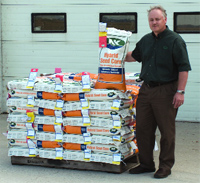
News
Safely store certified seed
Storing certified seed in a safe environment...
November 22, 2007 By Top Crop Manager
 Storing certified seed in a safe environment is just as important as using the right crop inputs and protection. Investing in the highest quality seed helps ensure a strong start to the season. Increasingly, growers have been buying seed early for the best selection at the best prices and to avoid delivery delay in the spring.
Storing certified seed in a safe environment is just as important as using the right crop inputs and protection. Investing in the highest quality seed helps ensure a strong start to the season. Increasingly, growers have been buying seed early for the best selection at the best prices and to avoid delivery delay in the spring.
From the minute the purchasing decision is made until planting begins, safe storage is critical. Gary Bauman, manager of technology and agronomic services at Syngenta Seeds Canada, offers tips on how to keep seed in prime condition.
• Buy high quality seed that has been properly cleaned, treated and tested. Most seedborne diseases can be prevented before they begin with the correct use of seed treatments.
• Store seed in a clean, dry and cool environment. Temperatures approaching 27 degrees C may adversely affect germination and vigour.
• Clean equipment thoroughly between transporting bulk loads to ensure that seed does not become contaminated. It would take only a handful of commercial corn to contaminate a bulk load of certified soybean seed, which if it is unintentionally planted into the soybean field, can reduce your options for exporting the soybean crop.
• Handle seed with care. Tossing or dropping seed will injure the germ and crack or split sensitive seed coats, adversely affecting vigour and emergence.
• Manage pests. The biggest pest affecting stored seed is mice. Although they are easier to trace than many other pesky pests, they can be just as destructive. Without detection, mice can infest and contaminate much of the stored seed before it ever gets planted.
• Follow recommended safety precautions. This is paramount, particularly when dealing with treated seed. Full protective gear, including gloves and goggles, should be worn at all times.
• Keep detailed records of seed purchases, retain samples of certified tags and ensure that the right seed gets planted in the right field. Grabbing the wrong bag can be a costly mistake!
“Certified seed not only ensures genetic purity and traceability, it also provides higher yields, improved vigour and consistent germination,” says Bauman. “Put your certified seed to work and retain its full value by following these quick and easy steps.”